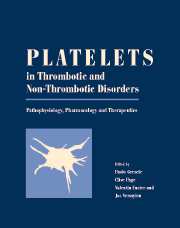Book contents
- Frontmatter
- Contents
- List of contributors
- Editors' preface
- PART I PHYSIOLOGY
- PART II METHODOLOGY
- PART III PATHOLOGY
- 34 Hereditary thrombocytopenias
- 35 Thrombocytopenias due to bone marrow disorders
- 36 Immune-mediated thrombocytopenia
- 37 Thrombocytopenia in childhood
- 38 Alloimmune thrombocytopenia
- 39 Drug-induced and drug-dependent immune thrombocytopenias
- 40 Thrombotic thrombocytopenic purpura and hemolytic uremic syndrome
- 41 Thrombocytosis and thrombocythemia
- 42 Platelet adhesive protein defect disorders
- 43 Congenital disorders of platelet secretion
- 44 Congenital platelet signal transduction defects
- 45 Acquired platelet function defects
- 46 Platelet storage and transfusion
- 47 Pathophysiology of arterial thrombosis
- 48 Platelets and atherosclerosis
- 49 Platelet involvement in venous thrombosis and pulmonary embolism
- 50 Gene regulation of platelet function
- 51 Platelets and bacterial infections
- 52 Interactions of viruses and platelets and the inactivation of viruses in platelet concentrates prepared for transfusion
- 53 Platelets and parasites
- 54 Platelets and tumours
- 55 Platelets and renal diseases
- 56 Platelets and allergic diseases
- 57 Platelet interactions with other cells related to inflammatory diseases
- 58 Platelets and the preimplantation stage of embryo development
- 59 Platelets in psychiatric and neurological disorders
- 60 Platelets in inflammatory bowel disease
- PART IV PHARMOLOGY
- PART V THERAPY
- Afterword: Platelets: a personal story
- Index
- Plate section
34 - Hereditary thrombocytopenias
from PART III - PATHOLOGY
Published online by Cambridge University Press: 10 May 2010
- Frontmatter
- Contents
- List of contributors
- Editors' preface
- PART I PHYSIOLOGY
- PART II METHODOLOGY
- PART III PATHOLOGY
- 34 Hereditary thrombocytopenias
- 35 Thrombocytopenias due to bone marrow disorders
- 36 Immune-mediated thrombocytopenia
- 37 Thrombocytopenia in childhood
- 38 Alloimmune thrombocytopenia
- 39 Drug-induced and drug-dependent immune thrombocytopenias
- 40 Thrombotic thrombocytopenic purpura and hemolytic uremic syndrome
- 41 Thrombocytosis and thrombocythemia
- 42 Platelet adhesive protein defect disorders
- 43 Congenital disorders of platelet secretion
- 44 Congenital platelet signal transduction defects
- 45 Acquired platelet function defects
- 46 Platelet storage and transfusion
- 47 Pathophysiology of arterial thrombosis
- 48 Platelets and atherosclerosis
- 49 Platelet involvement in venous thrombosis and pulmonary embolism
- 50 Gene regulation of platelet function
- 51 Platelets and bacterial infections
- 52 Interactions of viruses and platelets and the inactivation of viruses in platelet concentrates prepared for transfusion
- 53 Platelets and parasites
- 54 Platelets and tumours
- 55 Platelets and renal diseases
- 56 Platelets and allergic diseases
- 57 Platelet interactions with other cells related to inflammatory diseases
- 58 Platelets and the preimplantation stage of embryo development
- 59 Platelets in psychiatric and neurological disorders
- 60 Platelets in inflammatory bowel disease
- PART IV PHARMOLOGY
- PART V THERAPY
- Afterword: Platelets: a personal story
- Index
- Plate section
Summary
Although hereditary thrombocytopenia is overall a very rare disorder, many different forms have been well described. Inherited thrombocytopenia is frequently mistaken for an acquired platelet disorder. A careful medical and family history can generally allow differentiating congenital from acquired thrombocytopenia based on the duration of symptoms and the onset early in childhood. A detailed pedigree will often help to identify the inheritance pattern. The recognition of hereditary thrombocytopenia is important for avoiding potentially expensive and harmful treatments, as frequently administered in acquired chronic platelet disorders, and which will furthermore mostly be ineffective.
Some patients with hereditary thrombocytopenia have no clinical symptoms due to the moderate or mild thrombocytopenia and are most often detected by chance, due to the routine automated platelet counting and frequently associated automated mean platelet volume determination, when studying the peripheral blood. For this reason, probably more patients are being detected during recent years. It is only in the last few years that the underlying molecular abnormalities have become obvious. Due to the efforts of many research groups, the responsible gene, the defective gene product and the pathogenesis of many of these disorders have been unravelled. For many of these disorders, the clinical picture was well known and only recently the responsible gene and gene product were discovered. For others, the molecular mechanism was first unravelled in mice, and the human pathology was only discovered and defined by analogy with the animal model. Interestingly, discovering the molecular mechanisms of hereditary thrombocytopenia has led to a better understanding of the normal physiology of hematopoiesis.
- Type
- Chapter
- Information
- Platelets in Thrombotic and Non-Thrombotic DisordersPathophysiology, Pharmacology and Therapeutics, pp. 515 - 527Publisher: Cambridge University PressPrint publication year: 2002
- 4
- Cited by



